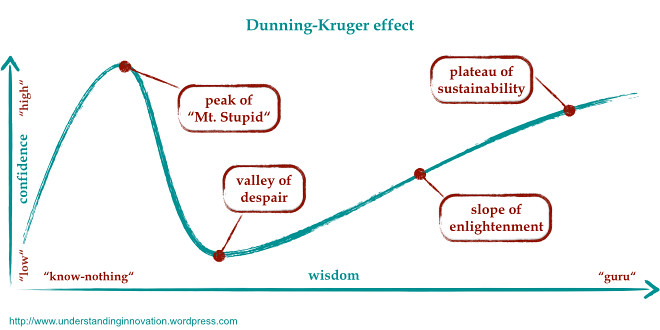|
|

楼主 |
发表于 2018-9-1 10:38:52
|
显示全部楼层
本帖最后由 PanShiBo 于 2018-9-3 07:59 编辑
Alpine Tip #60: The world's most dangerous peak is called "Mount Stupid"
I wish all beginner alpine courses started with introduction to "Mount Stupid". So that, I believe many (often fatal) alpine accidents would not have happened. In the science of psychology, this has a formal name of The Dunning-Kruger effect.

Typical scenario - an absolute beginner ("what's the heck is an Overhand Knot?!") grabs a quick basic 4-days mountaineering course or even "just learns from friends", or even just watches YouTube, or even learns nothing just borrowing cool and shiny mountaineering equipment. Climbs some of the technical routes under supervision, as a second it is quite possible to climb anything, and may be leads an easy route. All success! What happens after this is a scientific fact - he now imagines himself to become a sudden expert in everything, looking down (often with inner contempt) on real veterans, on his climbing partners and even on his own past instructors. Welcome! - this is the peak of Mt. Stupid. Then he goes climb the next trip and gets badly hurt or worse. To my own embarrassment, I have been myself on the very top of Mt. Stupid - because it is scientific fact, nobody can avoid it. I "knew" many things, like when it is safe to climb under a snow cornice, or when a snow slope is stable (and so avalanche-safe), or that go ice-climbing seracs is a very good idea, but these days I am not so sure anymore.
I have seen other people fast approaching the top of Mt. Stupid, and warned them about the danger to no avail - this is like to say to an alcoholic he is an alcoholic - it will be venomously denied. "Who? Me? No way!". I have seen the same people who were warned get hurt. More than once I had to visit funeral homes for the last good-bye. That's why 90% of aspiring "alpine climbers" don't last longer than one season - after a few epics they quit. I only got to know one alpine climber who, in the first three-four seasons never led - most of his ascents were guided, or as a second, even on class 3 routes! He is still around, healthy and climbing.
And of course, the worst is when such a Mount Stupid "expert" begins organizing (and leading) technical trips, just take a look at social media and local sports clubs - always such a "leader" is surrounded by bunch of another Mt. Supid experts and/or beginners (都是滥竽充数的人) - no veteran will join because they know what's going on. The sure sign of this type of trips is the team's size - if it is bigger than 4 (2 rope teams of 2 for glacier travel, otherwise 1 rope team of 2 is best). The trouble is readily available to strike. And it does strike, often real hard.
So the question is - when the Mount Stupid is past over? The answer is: when one sobers up from his false over-confidence binge and gets paranoid on any route harder than class 2 and takes double precaution, even on the routes he has already climbed. Welcome to the next point, "The Valley of despair".
On a side note - I am sometimes asked if this or that alpine course is worth taking. My advise (subjective!) : "Avoid the training if the instructor hasn't lead-climbed at least 5 technical routes in the past 12 months. Grab the course if the instructor has lead-climbed at least 5 techincal routes every year in the past 5 years". Same applies to the alpine trips/leaders. This rule makes sense, but who is doing such screening before enrolling?
|
|